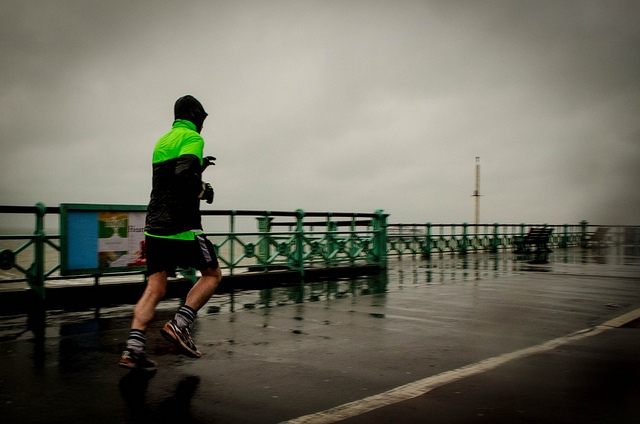Saturday's long run took place in a slow but steady and cold rain. It reminded me of the Hartford Marathon, which occurred under similar circumstances (minus the snowbanks and ice). The morning of that race, I sat in my car, refusing to disrobe and check my bag until the last possible moment.
In the end, the weather didn't matter--I ran a marathon PR of 3:09:47. That, I realized, was precisely the point. Rain, like any other adverse weather, requires a different mindset than the ideal overcast, 50-degree day--but unlike blazing heat, bitter cold or blinding snow, I've learned from experience that rain can be easily overcome.
I didn't always feel that way. For years, I hated running in the rain. I'd postpone key workouts just to avoid the rain. (That's actually a bad idea: As Hartford proved, you never know when you'll face adverse conditions on race day. You need to train through bad weather.) I could get wet and dirty and disgusting in the snow, but not the rain. Don't ask me why; I have no idea.
Running a PR in Hartford definitely helped me overcome my general unwillingness to run in the rain--so much so that I didn't even bother checking the forecast on Saturday and didn't care when I started to get wet before I even got off the porch. Here's the approach I now take to running in the rain; hopefully my tips will help if you, too, fear the rain.
Dress down. I've mentioned before the general rule of thumb that you should try to dress as though this it's 15 to 20 degrees warmer than it actually is. This is especially important in the rain. At Hartford, most everyone else wore long-sleeve shirts and pants to stay warm. On the other hand, I wore a tank and shorts even though it wasn't even 50 degrees at gun time. I shivered on the line, and for the first several minutes of the race, but I didn't regret my wardrobe. Why? Less fabric to get soaking wet and therefore weigh you down.
Dress bright. If it's raining, the sun's not out. If the sun's not out, it's probably at least a little dark. If it's at least a little dark, cars may not see you. If cars may not see you, bad, bad things can happen. Don't let bad, bad things happen. Wear a bright shirt or a lightweight vest.
Get good socks. Contrary to popular belief, blisters don't need to be a rite of passage for runners. If you have good running socks, you can run through puddles all day long without getting blisters. These are expensive, yes, but you only need a few pair; I reserve them for race days, long runs and speed or tempo workouts when I know it will be wet.
Don't think about it. Easier said than done, I know, but you need to stop thinking about the rain. Remember, you'll be soaked after about 10 minutes anyway. After that, who cares how much more it rains?
Don't worry about puddles. Yes, you should try to avoid puddles; no one likes running with cold, wet feet. That said, see my previous point--you're going to be soaked after 10 minutes, and the same goes for your feet. If I have to choose between running through a puddle or flinging myself into traffic, I'll take the wet feet.
Be careful. A couple previous points touch on this, but it behooves you to be careful. It takes cars a little longer to stop and to see what's in front of them. Let the drivers win: Don't run in front of a car until you make eye contact with the driver and he or she either waves you on or cuts you off because he or she forgot the first lesson of driver's education or can't hit the brake and send a text message at the same time.
Do laundry ASAP, if not sooner. Everything I wore Saturday went into the wash once I'd showered and eaten. If you don't have enough laundry to constitute a full load, wash your clothes in the bathroom sink and hang them up to dry. At worst, find an out-of-the-way place to lay your clothes out to dry in the meantime. Your roommates/significant other/children/pets will thank you.

No comments:
Post a Comment